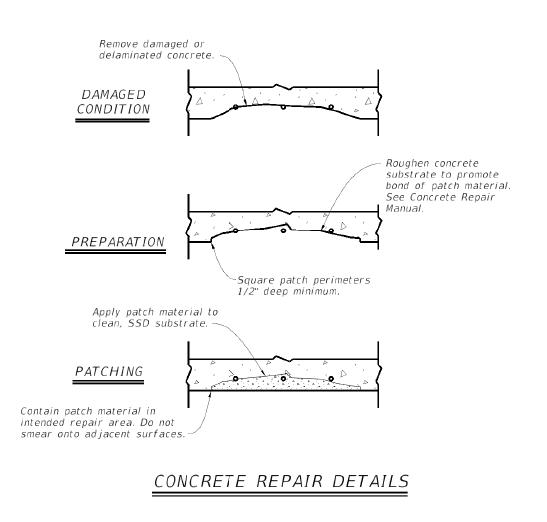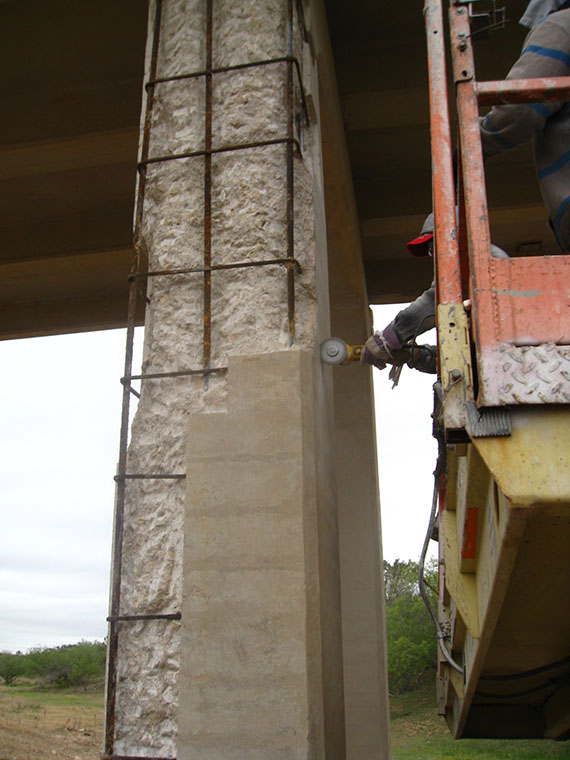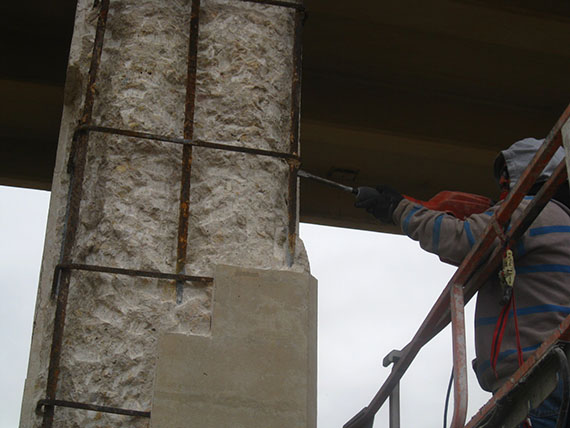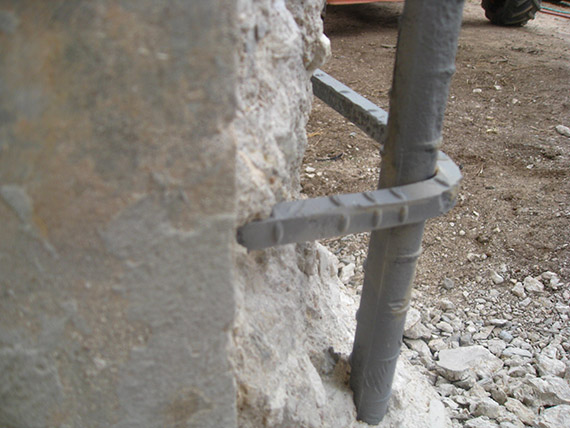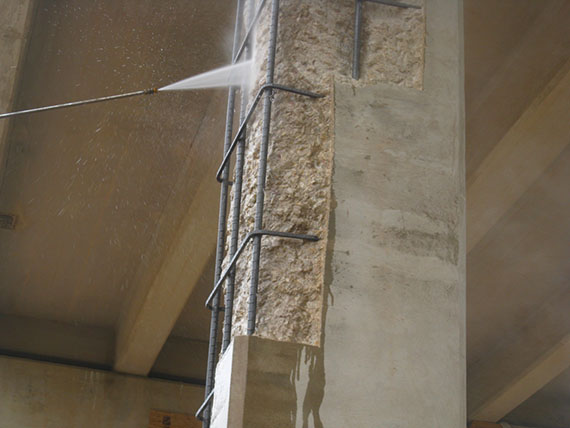Section 2: Intermediate Spall Repair
Anchor: #i1003284Description
Most intermediate spalls, as defined in Section 1 of Chapter 2, are repaired using proprietary, bagged concrete repair materials.
Extending bagged cementitious repair material with coarse aggregate can significantly reduce the potential for shrinkage and cracking. When feasible, the Contractor should either use a pre-extended repair material or add coarse aggregate (typically pea gravel) as allowed by the manufacturers. Using extended material is often not practical when using trowel-applied materials in vertical and overhead applications.
It is a common misconception that higher compressive strength equals a better repair. In reality, excessively high compressive strength can lead to early failure as a result of excessive loads being transferred into the repair material. Engineers and Contractors should typically select materials that have only enough strength for the intended use. In most cases intermediate spall repairs will be non-structural in nature, and therefore compatible or lower compressive strengths are beneficial.
In general, slower strength development means better long term performance. Often, Contractors select rapid strength-gaining repair materials even when it is not necessary to do so. When it is practical, standard (non-rapid) strength-gaining materials should be selected.
Batched concrete should generally be used when repairing intermediate spalls in precast fabricator yards since it is readily available. Likewise, batched concrete should be used on construction sites when practical. Although bagged mixes can work well when applied correctly, batched concrete is typically a better alternative since the material properties will very closely match those of the parent concrete. Follow the provisions in Section 3 of Chapter 3 when using batched concrete to repair intermediate spalls. Ensure maximum aggregate size is no larger than 1/3 of the clear space between reinforcement or the cover. For small repair area, the largest of the coarse aggregate can be removed using a sieve to allow the material to flow adequately in the confined repair spaces.
Anchor: #i1003317Material
Proprietary, cementitious repair mortars and concretes (pre-extended with coarse aggregate) typically consists of a mixture of the following:
- Anchor: #RFNBDANS
- Prepackaged dry material, and Anchor: #GIPPSYNL
- Either water or a proprietary liquid component supplied by the manufacturer.
Only preapproved materials listed on the MPL for DMS 4655, Concrete Repair Materials, should be used on TxDOT projects. The MPL includes several repair categories. The Engineer should specify on the plans which category or categories are acceptable in specific applications.
Use neat materials for applications up to 2 inches thick. Use extended materials for repairs exceeding 2 inches. Some neat materials may be extended in the field with appropriate aggregate. Consult the manufacturer's recommendation for aggregate properties and extension proportions. The repair material MPL differentiates between materials that may be extended in the field, those that are pre-extended, and those that are only approved neat.
Minimum application thickness can vary depending on the material and size of coarse aggregate (if applicable). Consult the manufacturer’s technical data to determine minimum thicknesses when determining minimum acceptable thickness, especially when working with extended materials.
For vertical and overhead repairs, limit lift thickness to 2 inches or the maximum permitted by the repair material supplier, whichever is less. Roughen the surface of materials that will receive subsequent lifts, and ensure substrate is clean and saturated surface dry prior to placing additional repair material.
Shelf life of repair material is critical, follow manufacturer’s published recommendations for storage including temperature and humidity controls. Do not expose material to the environment for extended periods of time. For projects with greater than 1000 square feet of concrete repair, store material off-site. For short durations, not to exceed three days, prepackaged material may be stored on-site but must be raised off the ground and covered in waterproof tarps. Material exposed to the environment and showing signs of packaging wear should not be used until tested and approved by Materials and Tests Division. Retain manufacturer lot tags with packaged date and shelf life for inspection prior to product use.
Anchor: #i1003372Repair Procedure
- Anchor: #EOYIWSBK
- Surface preparation.
- Anchor: #NRVKXISK
- Remove any damaged
or loose concrete.
- Anchor: #POSQHWCI
- Avoid damage to sound concrete that is to remain in place. Anchor: #IIRFYWIY
- Unless otherwise approved by the Engineer, use only hand tools or power-driven chipping hammers (15-lb. class maximum) to remove concrete.
Anchor: #IFTQKFHG - If more than 1/2 the perimeter of any
mild reinforcement is exposed or if the exposed bar exhibits significant
corrosion, remove the concrete from around the entire bar.
-
Anchor: #SIUALXJL
- Provide ¾-inch clearance or 1.5 times
the largest sized aggregate in the repair material, whichever is
greater, between the steel and surrounding concrete to permit adequate
flow of the repair material.
NOTE: A good rule of thumb is that adequate clearance is attained when you are able to wrap your fingers around the bar. Ensuring that you can grab the bar is a simple but highly effective method of ensuring there is adequate clearance to permit the repair material to flow around the exposed bar.
Anchor: #UVIAWXSE - Do not chip around prestressing strand that is exposed anywhere away from the immediate end of the member. Consult the Engineer when repairing an area in which prestressing strands have been exposed. When repair dictates that chipping occur around exposed strands, the Contractor must avoid striking the strands directly or otherwise causing damage that could lead to wire or strand breaks. Anchor: #IHPGDBKJ
- Use abrasive blasting to remove rust from exposed steel surfaces.
Anchor: #PPEILDQG - Provide ¾-inch clearance or 1.5 times
the largest sized aggregate in the repair material, whichever is
greater, between the steel and surrounding concrete to permit adequate
flow of the repair material.
- Saw-cut the repair perimeters
to eliminate feathered edges and to ensure that the repair material
will be applied in depths no less than 1/2 inch.
-
Anchor: #ETGOPNHV
- Handheld grinders or saws may be used to square the repair perimeters. Anchor: #VLMFIYFK
- Do not over-cut the repair perimeters at the corners of the repair areas. Anchor: #SJGTFFKP
- When practical, undercut the repair perimeter at an approximate angle of 30 degrees such that the profile will help hold the repair material in place.
Anchor: #ELHJKPRE - Roughen the substrate to ensure that there will be a mechanical bond between the repair material and the parent concrete. Though difficult to quantify and measure, Contractor should attempt to attain a minimum surface roughness profile of 1/8 inch or CSP (Concrete Surface Profile) 6 per ICRI. Anchor: #ROVFHIDG
- If the damage occurs at the end of a member
and prestressing strand is exposed, recess the strands a minimum
3/8 inch using a torch or other approved method. Do not overheat
or damage the surrounding concrete.
Figure 3-1. Typical Repair Details
Figure 3-2. Preparation (saw-cutting) straight and squared edges to contain repair material.
Figure 3-3. Chipping hammer used to remove unsound concrete.
Figure 3-4. Verifying adequate clearance around reinforcing.
Figure 3-5. Abrasive blasting to clean reinforcing of rust/active corrosion.
Figure 3-6. Reinforcing cleaned and free of rust.
Figure 3-7. Pressurized water to clean and prepare surface (saturated surface dry).
Anchor: #TDDRIPRC -
NOTE: In the past some Contractors and Fabricators opted not to recess prestressing strands in spalled areas so the protruding sections could serve as dowels for the repair material. While the strands would serve well as dowels in those circumstances, they could be exposed to moisture and chlorides if the repair fails over the life of the structure. For that reason it is more important that the strand be completely recessed. Install anchors to hold the repair material in place.
Anchor: #BNCQFNLX - Mechanical ties that bind repair material
to the substrate can greatly decrease the risk of future delamination
and spalling. For most intermediate repairs, exposed steel serves
that purpose. However, there are scenarios in which no reinforcement
is exposed and thickness of the spall dictates that cementitious
repair material be utilized. In such cases it is necessary to install
anchors to help mechanically tie the repair material
to the parent concrete. When no mild reinforcement is exposed, install
anchors at no more than 6 inches on center
each way or as required by the Engineer. Refer to Standard Specification
Item 449 - anchor bolts. The anchors
must consist of one of the following and Figure 3-8 shows
detail for concrete repair with mechanical anchors:
-
Anchor: #DVJASQRU
- Stainless steel expansion anchors. The Contractor may propose to use other anchors, such as galvanized or zinc-painted metal. The Engineer will review on a case-by-case basis. Anchor: #JKERFDUB
- Rebar or threaded stainless steel pins (1/2-inch diameter minimum) anchored in place using TxDOT Type III anchoring adhesive. Remove any epoxy that leaks onto the patch substrate after the anchor is placed.
Figure 3-8. Concrete repair with mechanical anchors
Anchor: #LBRKLPNV - If installing expansion anchors:
-
Anchor: #QSRUXJTA
- Drill and clean the holes as required by the anchor manufacturer. Do not use a drill bit that has a larger diameter than that required. Anchor: #PERVWRTB
- Embed the anchor the minimum amount required by the manufacturer. However, the anchor should not be driven further than necessary. In order to function as intended the head of the anchor must protrude into the repair material.
Anchor: #PLXGMAKX - If installing dowels using anchoring adhesive:
-
Anchor: #WVMCWKRO
- Drill a hole 1/8 to 1/4 inch greater than the dowel diameter. Make the hole deep enough to permit a minimum 4-inch embedment of the dowel. Anchor: #NVBVLMJE
- Remove any contaminants from the hole using a brush or other mechanical cleaner. Anchor: #HNWWIEPC
- Just prior to installing the anchor, clean the hole using a high-pressure air compressor equipped with filters to remove all oil from the compressed air. Anchor: #MNEIOJQH
- Dry the concrete surface inside the hole prior to installing the dowel. Anchor: #CBWXFYOM
- Fill the hole approximately 1/3 full with the
adhesive. Twist the dowel as it is inserted. Ensure that the space
between the dowel and the concrete is completely filled with the
adhesive. Remove all adhesive from the concrete surface that leaks from
the hole after the dowel is inserted.
NOTE: When using anchoring adhesives it is critical to properly drill and clean the anchor holes and to place a proper amount of material to keep the anchors in place. The drilled holes must be thoroughly cleaned which should include the use of clean high pressure air and mechanical brushing. Also, if there is too little adhesive, the anchor will not have enough pullout resistance. If there is too much adhesive, the material can leak out of the anchor hole and create a bond breaker on the repair substrate. It is imperative that the Contractor follow the manufacturer’s instructions and the above guidelines.
Anchor: #SJGNVRWI - Where anchors are installed, ensure that there will be a minimum cover of 1/2 inch for stainless steel and 1 inch for non-stainless steel after the repair material is applied. Oftentimes anchors or dowels do not protrude far enough from the concrete substrate, leaving large depths of repair material unanchored to the parent concrete. Contractor should install anchors with the exposed edge of the repair in mind, not the outside surface of the parent material. Anchor: #FIHFJJYC
- Substrates must be clean and sound. Remove any contaminants, including laitance, oil, dust, debris, or other foreign particles. Anchor: #CJHRERDE
- Just prior to repairing, blast the repair area using a high-pressure air compressor equipped with filters to remove all oil from the compressed air.
Anchor: #TPWYRWOJ - Remove any damaged
or loose concrete.
- Mixing.
For small applications (less than 1 cubic yard total) use graduated measuring cups or containers to determine the proper quantity of each component per the manufacturer’s requirements, then dispense into a clean container. Thoroughly mix the components by mechanical means (electric drill or mortar mixer) per the manufacturer's requirements. Do not mix repair mortar or concrete by hand.
- Anchor: #MCKBMWHV
- Do not estimate the proper amounts while adding the different components. Anchor: #SHDGEYCF
- For vertical and overhead applications Contractors often need to limit the amount of water or liquid component in order to achieve a stiff mix. Consult the manufacturer’s literature for minimum requirements. Anchor: #WBMOXRKA
- If extending the mortar to produce concrete, add aggregate and mix in accordance with the manufacturer’s requirements.
When mixing more than 1 cubic yard use a mortar mixer, volumetric mixer, or other method approved by the engineer. Contractor must submit detailed procedures on equipment type, proportioning methods, minimum mixing time, and placement.
Many cementitious repair materials have relatively short working times (15 to 30 minutes).
- Anchor: #FNKXVVUX
- Do not mix materials until the surface preparation is complete and the substrate is ready for application of the repair material. Anchor: #TKXGJPNY
- Mix only the amount of material necessary for immediate application. Anchor: #CBKREVSE
- Review water requirements and temperatures. If the dry materials are left out in the environment, they can easily reach 90°F or higher. In cases where dry materials have elevated temperature, use cooled mix water to ensure workability. When performing repairs between the months of April and September, having ice to add to the mix water or using chilled water should be normal. It is much easier to use cooler repair material. Note that all the material set time and workability time shown on the material's product datasheet is based on a laboratory room temperature of 70°F. Anchor: #KSAUKVJX
- Do not attempt to make the material workable by over-mixing or adding additional liquid after it has begun to set. Over-mixing material that has begun to set can reduce the compressive strength and increase the permeability of the material. Exceeding maximum water content is bad for long term performance of repair material. Anchor: #SNHSJTKO
- The beneficial properties of bagged mixes are often lost when the repair material is retempered. Retempering of bagged mixes will not be permitted.
Anchor: #HWOIPWVP - Application.
Hot and cold weather application.
- Anchor: #QQMOLRMY
- The temperature of the repair material and the concrete substrate at the time of application must be between 40°F and 95°F. Contractor must also adhere to manufacturer limits if they are more stringent. Anchor: #RSAXFMYQ
- Do not apply repair material when the ambient temperature in the shade is below 40°F and falling. Repair material may be placed when the ambient temperature in the shade is 35°F and rising or above 40°F. Anchor: #VCSPWRTH
- Shade the repair material components and the repair substrate if the ambient temperature is above 100°F.
In almost all cases, the repair material should be applied over a Saturated Surface Dry (SSD) substrate. ACI CT-13, ACI concrete Terminology, defines saturated surface-dry (SSD) as condition of an aggregate particle or other porous solid when the permeable pores are filled with water and no water is on the exposed surfaces. In other words, SSD is achieved when the surface of concrete substrate is saturated with water to a depth of about 1/8 to 1/4 inches, but the exposed surface is devoid of free water, as if it had been dried with a towel.
Surfaces that will be repaired with a cementitious repair material should be in a saturated surface dry (SSD) condition immediately prior to material application. This condition is achieved by soaking the surfaces with water for 2 to 24 hours or pressure water jetting for at least 15 minutes just before repair material application. Concrete can be visualized like a sponge; when the substrate concrete material can no longer take on water like a sponge that is full, SSD condition has been achieved. Immediately before material application, the repair surfaces should be allowed to start drying. The surface should appear slightly damp, with no standing water.
Obtain an SSD condition using the following method:
- Anchor: #FXXSPOVA
- Several minutes before repairing, apply pressure water blast to the surface for a brief period (at least 15 minutes depending on the porosity of the concrete). An SSD condition is achieved if the surface remains damp until the repair material is applied.
Surface may be damp, but must be free of standing water.
Do not use a proprietary epoxy bonding layer in lieu of an SSD substrate unless approved by the Engineer. If use of a proprietary bonding agent is authorized, mix it in accordance with the manufacturer’s requirements. Use only TxDOT approved Type V or Type VII material (refer to DMS 6100 – Epoxies and Adhesives).
If trowel-applying the repair material:
- Anchor: #YIOXUFHG
- Apply over a bonding layer, which typically consists of a scrub coat brushed into the SSD substrate. Anchor: #OKDNHVKQ
- The scrub coat consists of a thin layer of repair mortar that is pushed into the surface using a stiff brush, completely covering the substrate and filling all voids. Ensure that there is not an excess amount of water on the brush used to apply the scrub coat. Anchor: #YAFVWPJQ
- Do not dilute the scrub coat material with additional liquid. Anchor: #BMEKLJRV
- Apply the repair material while the bonding layer is still wet (scrub coat) or tacky (proprietary bonding layer). Anchor: #KVOFKHFH
- Apply in minimum 1/2-inch and maximum 1 1/2–inch lifts unless otherwise approved by the Engineer. Anchor: #FEAGXBLF
- For multiple lift applications, roughen the surface of the preceding lift before it has reached initial set. Anchor: #YICSOAEH
- Wait until the preceding lift has reached initial set (refer to the product data sheet for estimated time frame) to prevent sagging prior to applying the next lift. Anchor: #EEYBMFSH
- Wet the surface just prior to applying the subsequent lift.
If repairing, using a form-and-pour method:
- Anchor: #SOHPYQMY
- Prepare and install the forms prior to mixing the repair material. Anchor: #AWGPEPSE
- Ensure that forms are tight enough to prevent grout leakage. Anchor: #UPLIXSNV
- Place the repair material in the forms while the bonding layer is still wet (scrub coat) or tacky (epoxy). Anchor: #LJWWQSRA
- Consolidate the material adequately. Refer to the product data sheet for consolidation instructions. Do not over-vibrate the mix. Do not vibrate self-consolidating concrete products.
If required by the Engineer, determine the compressive strength of the repair material by making concrete test cylinders.
- Anchor: #GUUEUAOX
- Curing.
Failures often occur in cement-based repair materials due to inadequate curing.
- Anchor: #PDRRKMJI
- Large plastic shrinkage cracks can develop if rapid moisture loss occurs before the repair has the capacity to resist tensile loads that develop as a result of the shrinkage. Anchor: #DGHSGSVA
- Drying shrinkage can lead to elevated stress levels that cause cracking within the repair material or at the bond line between the repair and the parent concrete. Anchor: #NXRCYRVC
- It is paramount to the long-term success of the repair that proper moist curing commence as soon as possible after application of the repair material, and that it continue for a sufficient amount of time thereafter.
After placing repair material, moist cure exposed repair material surfaces for a minimum of 72 hours using wet mats, water spray, or ponding. Do not use a curing compound in lieu of moist curing unless approved by the Engineer. Curing compound will only be considered for use when water curing will be unnecessarily burdensome and when allowed by manufacturer literature. If use of a curing compound is authorized, any remaining residue must be completely removed after the required curing period.
In form-and-pour applications, leave forms in place for a minimum of 72 hours after placing the repair material. Place wet mats on exposed sections and over the openings used to place the material.
The Engineer may reduce required curing time in some cases, such as when there is a need to return the member to service quickly or when CFRP will be placed over the repair material.
Do not allow concrete surfaces to become dry during the specified moist curing period. Ensure that wet mats are kept wet during the entire cycle.
Insulate the repair material to ensure that there is adequate heat for curing if ambient temperature is expected to fall below 50°F. If using artificial heating methods, do not heat the air around the repair material to above 130°F.
After curing, the repair area will be inspected visually for cracking and sounded by the inspector with firm hammer blows to ensure the repair has adequate bond without cracking and is free of soft or other unsound material. Acceptance of the repair will be based on the findings of this inspection.
- Anchor: #PJAAXABM
- Finish.
Ensure that the repairs closely resemble the surrounding concrete. Finish repair work as outlined in Item 427, Section 4.3.4 for Off-the-Form Finish.
- Anchor: #ELMEDWIM
- Blend in the repair area if after completing the work the repair material does not closely resemble the surrounding concrete. Perform blending or slurry coat finish after measurement of repair location has been completed. The Contractor may use a slurry coat finish in accordance with Item 427 to blend in the repair. The Engineer will review other methods proposed for blending repairs. Anchor: #PRXJPTDE
- Repairs should not be easily discernible if viewed from more than 25 feet away. Anchor: #OUIISWHL
- Measurement will be make prior to blending repair edges with parent material.
Commentary
When feasible, batched concrete is typically the best option for repairing intermediate spalls. However, it is often not practical to use batched concrete when working on existing structures or, in some cases, on construction sites. Using bagged mixes is also necessary when either trowel-applied or flowable form-and-pour mortar is needed in highly congested or thin applications. Proprietary cementitious repair materials can work effectively if applied correctly.
Each step in the repair process (preparation, proportioning, mixing, application, and curing) is critical in the overall performance of the repair material. The requirements set forth in DMS 4655, Concrete Repair Materials, ensure that only high quality materials will be added to TxDOT’s preapproved list. It is imperative that Contractors only use concrete repair materials that have been preapproved for the given application.
